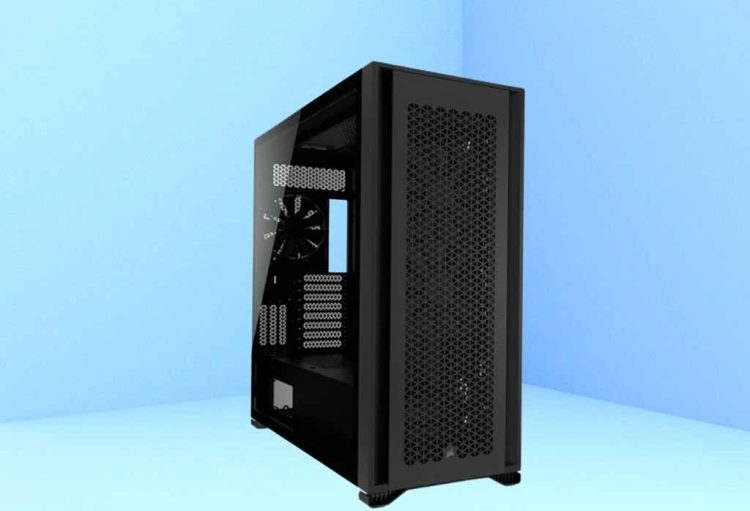The Corsair 7000D Airflow is a big PC case meant for building gaming or workstation machines. Its massive dimensions make it the right fit for installing bulky graphics cards, AIO coolers, and multiple storage devices at the same time.
Before we dig into further details, let’s have a quick glance at the pros and cons of the Corsair 7000D Airflow case.
Corsair 7000D Airflow PC Case Review
Corsair’s approach with the “D” Series chassis is totally different from most PC cases that we see today. Most PC cases in Corsair’s D-Series are neat and classic looking, and there are no fancy RGB lights and strips on them.
For example, the Corsair 4000D and Corsair 5000D both had no fancy look to them, indeed both of these were simple and classy. With the “D” Series chassis, you only get more room and better airflow.
However, jumping from previous versions like Corsair 4000D, and Corsair 5000D to Corsair 7000D, you will see a significant change in design. Especially, from the top and front, the Corsair 7000D has a very appealing look to it.
Specifications
| Specification | Description |
|---|---|
| Case Model | Corsair 7000D Airflow |
| Case Type | Full Tower |
| Dimensions (HxWxD) | 23.6 x 9.7 x 21.7 inches |
| Weight | 18.7 kg |
| Material | Tempered Glass |
| Motherboard Support | E-ATX, ATX, Micro-ATX, Mini-ITX |
| Maximum GPU Length | 450mm |
| Maximum CPU Cooler Height | 190mm |
| Maximum PSU Length | 225mm |
| Drive Bays | 3.5″ x 6 (2 included), 2.5″ x 4 (4 included) |
| Expansion Slots | 8x + 3x |
| Radiator Compatibility | Front: Up to 480mm, Top: Up to 360mm, Rear: Up to 120mm |
| Cooling Fan Support | Front: 3 x 120mm or 2 x 140mm, Top: 3 x 120mm or 2 x 140mm, Rear: 1 x 120mm (included) |
| Front I/O Ports | 4x USB 3.0, Optional USB-C, 3.5 mm Audio/Mic Combo |
| Dust Filters | Front, Top, Bottom (removable and washable) |
| Cable Management | Velcro straps, Cable routing channels |
| RGB Lighting | No |
| Warranty | 2 years |
Design
One of the most impressive factors when looking at the Corsair 7000D is its design. Like I’ve said earlier, this 7000D is more appealing and eye-catching as compared to previous models, the Corsair 4000D and Corsair 5000D.
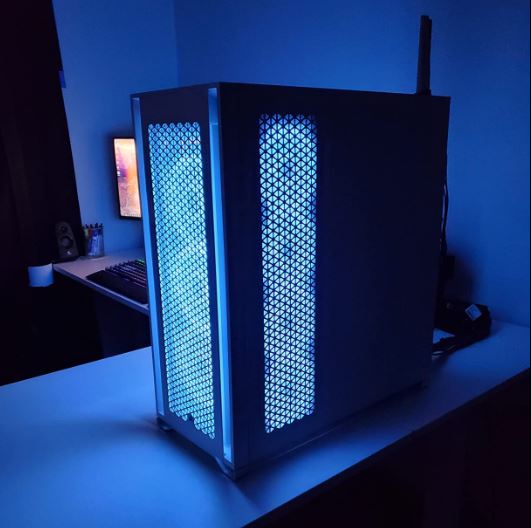
Standing at 23.6 inches in height and 9.8 inches in width, the Corsair 7000D airflow provides you with a massive playground for installing E-ATX motherboards, beefy CPU coolers, and large graphics cards.
I love this case from the front where there are mesh panels behind which you can install massive radiator fans up to 480mm to promote high airflow.
Now comes the front IO panel part which sits at the top section of the case. This is where you’ll find the x4 USB 3.0 ports, x1 USB Type-C port, and a headphone/mic combo jack.
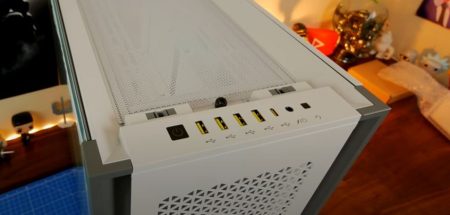
I think these ports are enough to quickly connect any flash drive, mice, or other hardware when needed. I personally use the front I/O panel, but if all of your rear I/O ports are filled, then the front I/O does give you the convenience to attach more devices when needed.
Internal Look
Now let’s have a look a the internals of the Corsair 7000D case, which is simple to do. The tempered side glass panels swivel to one side as soon as you push the side pins. You can also read our guide about how to open a PC case safely if you have any confusion.
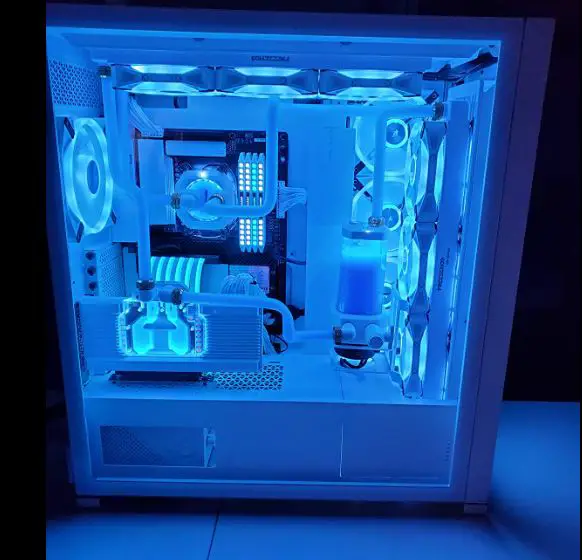
As you can see in the image above, there’s a lot of space for installing bigger (E-ATX) size motherboards inside this case. Even installing an E-ATX motherboard leaves plenty of space behind for fresh air to pass through and cool down components.
So, there’s cramping at all even if you put in full-size hardware inside this case. There are a total of 8x + 3x expansion slots inside this case, the latter 3 expansion slots are vertical.
On the other side of the case lies the cable routing system, which is way better than what I’ve found on the Corsair 5000D. Maybe Corsair has taken this seriously and they came up with better cable management this time in the 7000D.
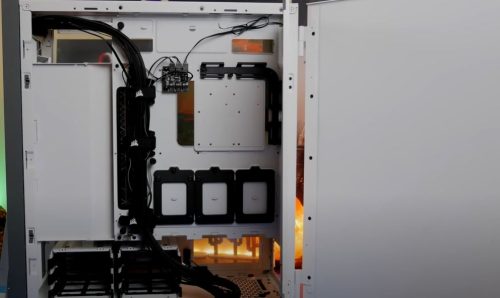
As soon as you open the side panel, you will be welcomed by Corsair’s RapidRoute cable management system, which we are continuously seeing since the launch of Corsair 4000D a few years back.
This is the section where you’ll find a lot of Velcro straps and plastic ties to tuck your cables in one place. Down at the bottom under the PSU shroud, you’ll find the resting place for your SSD and HDD drives. So there are plenty of storage options if you want to expand your storage later on.
I want you to take notice of one of these at this point, which is one of the drive cages messing with the PSU shroud at the bottom.
Although you can install beefy PSUs that are up to 225mm in length, you may have an issue fitting the power supply if the hard drive cage is right next to it. So I’ll advise you to remove one storage bay (the one right next to the PSU shroud) so that your beefy PSU can easily fit in.
All in all, the cable management inside the Corsair 7000D has improved a lot, and this is one of the best that I’ve seen so far in expensive cases like this one.
The only thing that was hindering the entire setup was the PSU shroud messing with expansion bays. Apart from that, I have no complaints to make about the cable management system in Corsair 7000D.
Cooling
The Corsair 7000D is all about airflow performance, its bigger dimensions allow the air to circulate fully inside before being exhausted out. Although the case comes with a pretty basic three 140mm fans setup, but you can simply mount fans up to 480mm for high airflow.
There are two fan trays (one at the front and one at the side of the case) to install multiple fans. The number of fans that you can install depends upon the size of the case fans.
You can install up to four 120mm fans at the front and the same goes for the side intake as well. The reason I recommend you go with 120mm fans is because they are quieter as compared to 140mm fans.
I’ve written an entire guide on how to improve airflow inside your PC case, don’t forget to check that out as well.
In order to prevent any dust particles from setting in, there are fine filters at the front, top, and side intake of the Corsair 7000D. This goes for the PSU shroud as well which has a fine filter to prevent the dust setting on the fan blades.

So yeah in terms of cooling performance, the Corsair 7000D is the king with multiple fan mount options to promote high airflow.
Accessories
There’s not much that comes with the Corsair 7000D apart from the preinstalled 140mm fans. However, there are some other useful accessories that Corsair does ship with in this case like a vertical GPU bracket, velcro straps, PWM extension cable, and replacement for PSU Shroud.
Acoustics
As the Corsair 7000D is more focused on improving the airflow and providing big ground for installing beefy hardware, it misses out on providing the dampening effect that most gamers or workstations prefer these days.
There are no sound-proof materials used in constructing this PC case, which peaks the sound levels at 41.8 dBA when the radiator fans are running at their full potential. This puts the Corsair 7000D airflow way below the Corsair 4000D airflow and Corsair 4000X when it comes to dampening the internal sounds.
Corsair hasn’t opted for any foam or rubber padding on the side panels, which plays a significant role in absorbing the noise coming out of your case. But you can simply soundproof your PC case manually without spending a lot of money on buying one that comes with soundproofing features.
Although the Corsair 7000D makes some noise, it’s hardly noticeable unless there’s dead silence in your room. After all, pulling in more air with 140mm radiator fans does trigger some sort of noise.
Maybe you can bring down the noise levels to a comfortable level by using 120mm radiators at the front and side intake. If you are living in a cold area, then I don’t think you will need the side intake fans to cool down your PC.
Verdict
Finally, the Corsair 7000D Airflow stands as the best option if you are building an extreme gaming machine or workstation that requires a lot of cooling. And by building an extreme machine what I mean to say is you are going after a large E-ATX motherboard, 2.5 slot graphics card, and a beefy AIO cooling solution.
It’s a massive PC case that will require some sort of ground to place it. There’s no way it will look good on your tiny computer desk or table. I’ll prefer placing the Corsair 7000D case on the floor due to its 23-inch (almost 2 feet) height.
Also, it’s one of the heaviest PC cases that I’ve encountered so far. Weighing around 18 kg, it would be difficult for you to move this case frequently from one place to another. Lastly, it’s expensive to get, it still costs over $250 to get the black variant of Corsair 7000D.
Apart from its massive size, weight, and higher price tag, I have found the Corsair 7000D to be the best for building high-end workstations or gaming computers.
It has a very nice and clean-looking design, and I’m sure it will blend with any type of hardware that you’ll put inside it. There’s a lot that this case offers in terms of airflow performance, expansion, and connectivity.

Hi, this is Masab, the Founder of PC Building Lab. I’m a PC enthusiast who loves to share the prior knowledge and experience that I have with computers. Well, troubleshooting computers is in my DNA, what else I could say….

